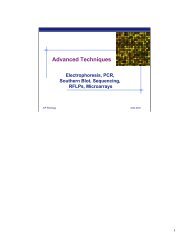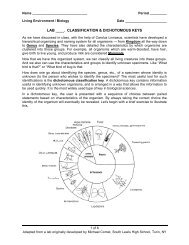Food Preferences of Slugs - Explore Biology
Food Preferences of Slugs - Explore Biology
Food Preferences of Slugs - Explore Biology
You also want an ePaper? Increase the reach of your titles
YUMPU automatically turns print PDFs into web optimized ePapers that Google loves.
Although the majority <strong>of</strong> the 40,000 species <strong>of</strong> gastropods live in the oceans or in freshwater, many species have evolved adaptations enabling them to live successfully on land.One <strong>of</strong> the most important <strong>of</strong> these is the evolution <strong>of</strong> a lung for breathing air.Anatomically, the lung is formed from the mantle cavity - the space between the bottom <strong>of</strong>the mantle and the top <strong>of</strong> the visceral mass. Air enters and leaves the lung through abreathing pore visible at the lower edge <strong>of</strong> the mantle on the right side. Its preciselocation is a feature used to help identify the different kinds <strong>of</strong> slugs.In at least one respect, snails and slugs do not seem to be as well adapted to life on land asinsects and the terrestrial vertebrates. Whereas these groups have a waterpro<strong>of</strong>exoskeleton or skin, the land-dwelling snails and slugs have a water-permeable skin. As aresult, they are vulnerable to dehydration (drying out) and death when confronted withhot, dry environmental conditions. At such times, snails can retreat into their shells, butslugs don’t have that option. Instead, they have two other strategies for survival. First,they can survive a water loss equal to 80% <strong>of</strong> their body weight. (A human being, incontrast, can only tolerate a 12% water loss.) Second, they avoid potentially stressfulsituations by hiding under leaf litter, logs, rocks, etc. during the heat <strong>of</strong> the day. Theyemerge to feed when conditions are cooler and damper, particularly at night or following arain.<strong>Slugs</strong> are hermaphrodites with reciprocal mating. Each slug produces from 500 to 800eggs. Each egg is from 1/16 to 1/8th inch long, whitish, and laid in moist soil among plantroots. The eggs are usually deposited in groups <strong>of</strong> 50 and hatch in 3 weeks (or overwinter). Adult slugs that survive the winter may lay eggs in May. By October, the newlyhatched eggs should have developed into slugs sufficiently mature to mate and lay eggs.The slug was introduced into the U.S. from Europe, during the early part <strong>of</strong> the lastcentury. It first appeared in port cities such as Boston, New York, and Philadelphia. It isnow widely distributed over the eastern U.S. The common species <strong>of</strong> slugs found in thisregion are generally herbivores, feeding on a variety <strong>of</strong> plants. Because many <strong>of</strong> theseplants are cultivated fruits, vegetables, and ornamentals, some kinds <strong>of</strong> slugs areconsidered pests. When present in high numbers, they can be very destructive in gardensand greenhouses.1. The slug is an example <strong>of</strong> an ‘‘introduced species’’ that has become a pest. Can youthink <strong>of</strong> other introduced species that have become pests?2. What reasons can you suggest for the fact that introduced species tend to beecologically and/or economically destructive?©2000 CIBT <strong>Food</strong> <strong>Preferences</strong> <strong>of</strong> <strong>Slugs</strong> – Supplemental Reading Section Page 2
















